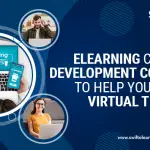The Importance of Interactive eLearning Content Development
eLearning has become an increasingly popular way for organizations to deliver training and education to their employees and learners. However, creating eLearning content can be a daunting task. Here are some tips for eLearning content development to help you create effective and engaging courses.
1. Start with learning objectives
Before you begin creating your eLearning content, it’s essential to define your learning objectives. What do you want your learners to achieve? What skills or knowledge do you want them to acquire? Having clear learning objectives will help you structure your content and ensure that it’s relevant and focused.
2. Choose the right format
There are several formats you can use when creating eLearning content, such as videos, interactive quizzes, simulations, and animations. Choosing the right format depends on the content you are delivering and your learners’ needs. For example, if you are teaching a technical subject, simulations may be more effective than videos.
3. Keep it simple
One of the biggest mistakes in eLearning content development is trying to cram too much information into one course. Keep it simple and focus on the most important concepts. Break up the content into smaller modules or chapters to make it more digestible.
4. Use multimedia elements
Multimedia elements, such as images, videos, and audio, can make your eLearning content more engaging and interactive. These elements can help to break up the monotony of the content and provide your learners with a visual representation of the concepts you are teaching.
5. Incorporate interactive elements
Interactive elements, such as quizzes, polls, and games, can help to keep your learners engaged and motivated. They also provide immediate feedback, which can help your learners to understand the material better and retain it for longer.
6. Personalize the content
Personalizing the content can help to make your eLearning content more engaging and relevant to your learners. Use examples that are specific to your learners’ industries or job roles and use their names in the content where appropriate.
7. Test your content
Before launching your eLearning content, it’s essential to test it thoroughly. This includes checking for any technical issues, such as broken links or videos that don’t play correctly, as well as checking the content for accuracy and relevance.
8. Continuously update your content
E-Learning content development is an ongoing process. As technologies change, new information becomes available, or learners’ needs evolve, it’s important to update your content to ensure it remains relevant and effective.
In conclusion, eLearning content development requires careful planning and consideration of your learners’ needs and learning objectives. By following the tips above, you can create effective and engaging eLearning content that will help your learners to acquire the skills and knowledge they need to succeed. Remember, the key to creating effective eLearning content is to keep it simple, interactive, and relevant to your learners.

